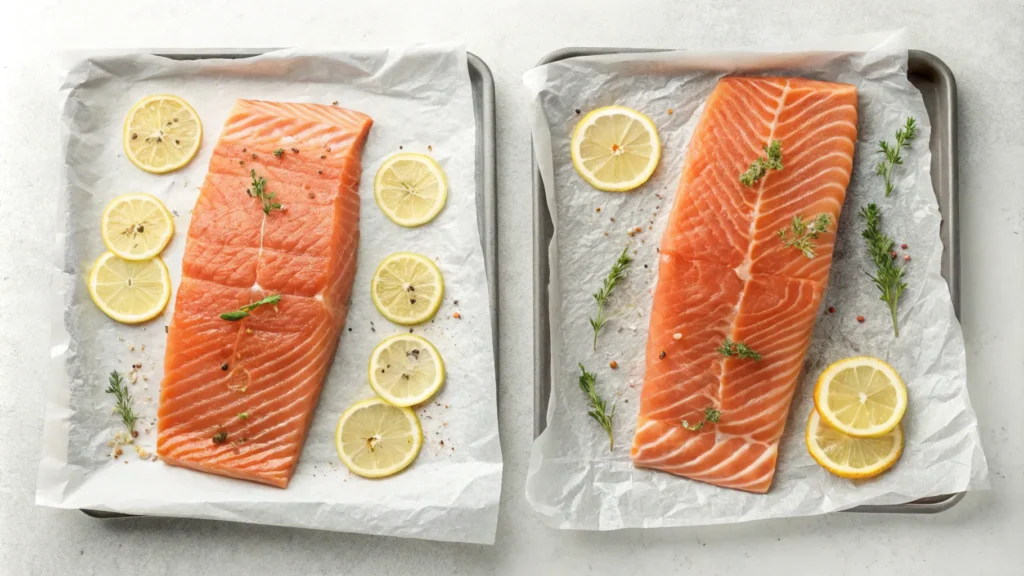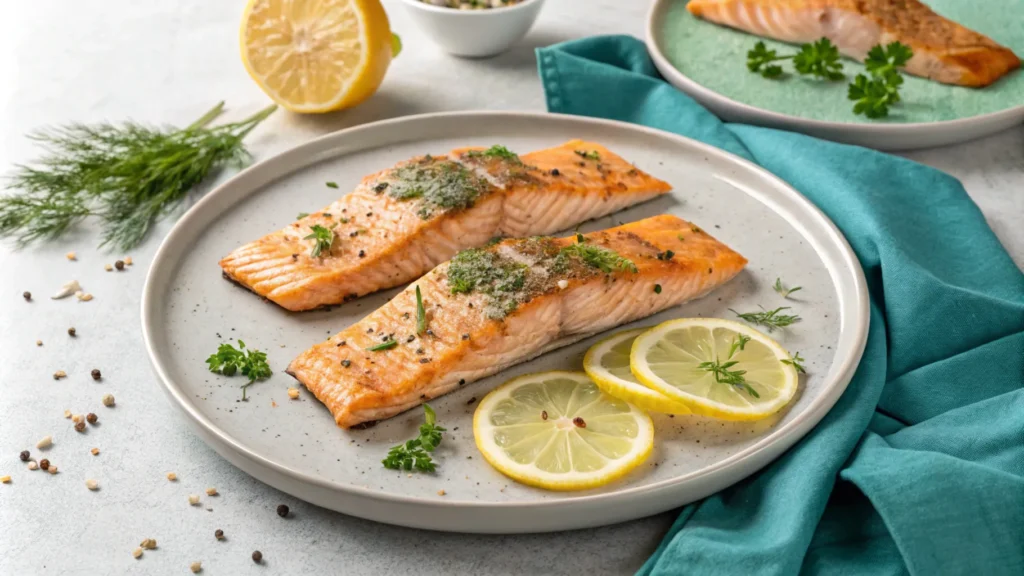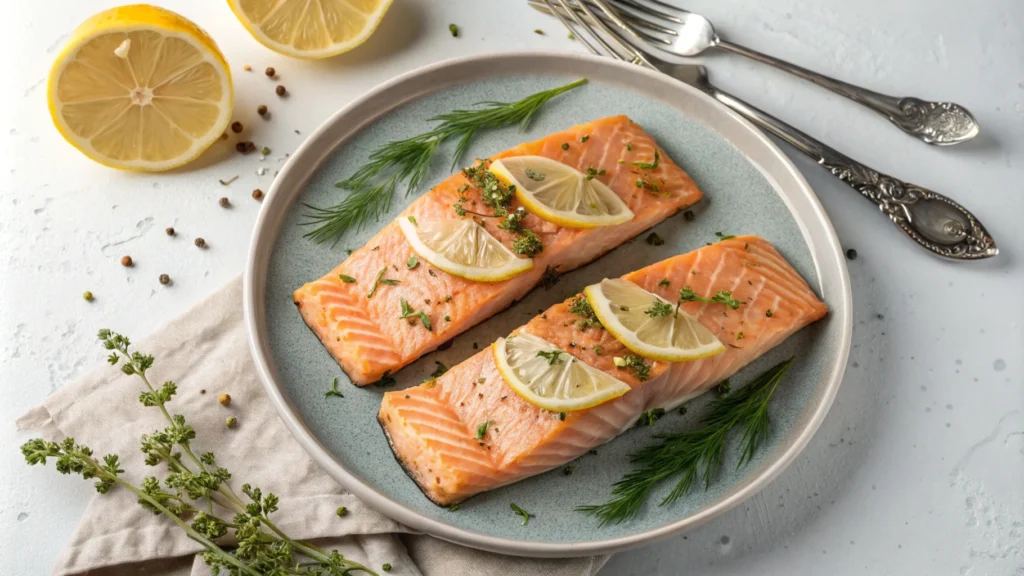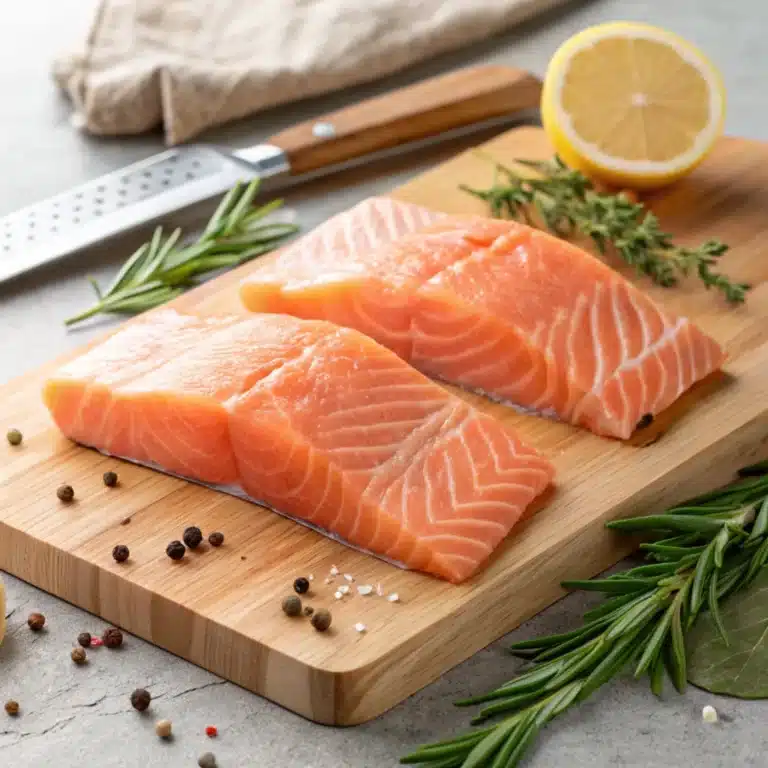Salmon is a culinary favorite celebrated for its rich flavor, versatility, and health benefits. But cooking the perfect salmon can feel like a mystery to many. This article unravels the secret to the best salmon, exploring how to choose the finest cuts, master cooking techniques, and pair salmon with accompaniments that make it shine. From stovetop searing to sous vide, we’ll cover it all. Let’s dive in and take a closer look at this incredible fish.
Table of Contents
Understanding What Is the Secret to the Best Salmon
Salmon is a true culinary gem, loved not only for its taste but also for the nutritional benefits it brings to the table. Let’s break it down.
Types of Salmon: Unfastening the Secret to Flavorful Fish
Salmon comes in various types, each with its own unique qualities. Wild-caught varieties like sockeye, coho, and Chinook boast vibrant colors and robust flavors. Farm-raised salmon, on the other hand, typically has a milder flavor and a softer texture, making it a versatile choice for certain dishes. Understanding the differences allows you to select the best option for your dish.
Why Freshness Matters for the Best Salmon
Nothing beats fresh salmon when it comes to flavor and texture. A fresh cut should have a mild, ocean-like scent and firm, moist flesh. Steer clear of salmon with a strong fishy smell or dull color—these are clear indicators that it’s no longer fresh. Remember, freshness is key to Unlocking the secret of the best salmon.
Nutritional Perks of Perfectly Cooked Salmon
Beyond taste, salmon is a powerhouse of nutrition. Packed with omega-3 fatty acids, high-quality protein, and essential vitamins like B12 and D, it’s a fantastic choice for maintaining heart health, boosting brain function, and supporting overall wellness. Incorporating salmon into your meals tantalizes your taste buds and nourishes your body.
Selecting Quality Salmon for the Best Taste
When you think about the secret to the best salmon, the answer often starts with choosing the right fish. Every detail matters when selecting quality salmon for your meal, from where it’s caught to how it looks.
Wild-Caught vs. Farm-Raised Salmon: Which Is the Best Choice?
The choice between wild-caught and farm-raised salmon is more than just preference. Wild-caught salmon, sourced from natural habitats like rivers and oceans, boasts a richer flavor and firmer texture due to its active lifestyle. While milder in taste, farm-raised salmon offers a softer, fattier texture and is often more affordable. If you want bold flavors, go wild; farm-raised might be the way for creamy dishes.
How to Pick Fresh Salmon Like a Pro
Freshness is crucial when seeking the best salmon. Depending on the species, look for vibrant flesh, whether pink, red, or orange. The skin should be shiny and moist, not slimy. A gentle press on the flesh should leave no indentation—it should bounce back. Always trust your nose, too: fresh salmon smells clean and mild, like a fresh breeze from the sea.
Seasonal Tips for Finding the Best Salmon
Seasonality can make a big difference in flavor and quality. Wild salmon is typically at its best from late spring to early fall, aligning with natural migration patterns. Frozen wild-caught salmon is an excellent alternative during the off-season, as it’s often flash-frozen at peak freshness.

Preparing Salmon to Unfasten What Is the Secret to the Best Salmon
Now that you’ve picked your fish, it’s time to prepare it for cooking. Mastering preparation is another vital step in uncovering the secret to the best salmon. A little effort before cooking makes all the difference.
Cleaning and Deboning: Essential Steps for Best Salmon
A clean fish is a happy fish! Start by rinsing the salmon under cold water and patting it dry with a paper towel. Then, use tweezers or a fish bone remover to gently pull out pin bones. Run your fingers along the flesh to feel for hidden bones—it’s better to find them now than later.
The Role of Marinades and Dry Rubs in Salmon Perfection
Marinating salmon can infuse it with bold flavors. A simple mix of olive oil, soy sauce, garlic, and lemon juice works wonders when left to soak for 15–30 minutes. Prefer to keep it quick? A dry rub of salt, pepper, and smoked paprika Improves the fish’s natural taste while forming a flavorful crust during cooking.
Resting Salmon: A Step You Shouldn’t Skip
Don’t rush into cooking straight out of the fridge! Let the salmon rest at room temperature for about 15 minutes before you start. This simple step Secures more even cooking, helping you achieve that perfect flake and texture.
Cooking Methods That Unfasten What Is the Secret to the Best Salmon
Cooking salmon to perfection is as much an art as a science. The cooking method is crucial when uncovering the secret to the best salmon. Let’s discover the techniques that consistently deliver delicious results.
Slow Roasting: A Foolproof Method for Tender Salmon
Slow roasting salmon in the oven at a gentle temperature (around 275°F). Secures even cooking and locks in moisture. This method is foolproof for beginners and ideal for achieving that tender, flaky texture everyone loves. Season the salmon, place it on a baking sheet, and let the low heat work its magic.
Stovetop Searing: Crispy Skin, Perfectly Cooked Fish
Stovetop searing is unbeatable for a quick meal with irresistible crispy skin. Heat a skillet with oil until it shimmers, then place the salmon skin-side down. Press lightly with a spatula to prevent curling, and flip it briefly to finish. The contrast between the crisp exterior and the juicy interior is nothing short of divine.
Poaching for a Light and Juicy Result
Poaching salmon is a gentle technique that preserves its delicate flavor. Simmer water or broth with aromatics like lemon and dill, then add the salmon and cook until opaque. This method is perfect for creating light, moist fillets that are excellent in salads or paired with simple sides.
Sous Vide for Precision Cooking
Sous vide is a favorite for perfectionists. This method produces a buttery, evenly cooked fillets every time by cooking salmon in a vacuum-sealed bag at a precise temperature. Afterward, a quick sear adds flavor and color. It’s a bit more effort, but it’s worth it for a show-stopping dish.
Grilling for Smoky Flavor
Grilling salmon imparts a smoky, charred flavor that’s hard to beat. To prevent sticking, oil the grill grates and the fish, then cook over medium heat. A cedar plank can Improve the smokiness while keeping the fillet moist.
For additional tips and creative recipes, check out this guide to salmon bites on Masterly Recipes.

Enhancing Flavor with Accompaniments
The best salmon deserves the best accompaniments. Pairing salmon with the right sides and sauces Promotes flavor and complements its natural richness. Let’s discover how to make your salmon shine.
Perfect Pairings: Vegetables and Sauces
Roasted asparagus, steamed broccoli, or a light cucumber salad make excellent companions for salmon. Sauces like lemon-dill butter or a simple garlic aioli bring out the fish’s flavor without overpowering it. Try pairing salmon with a mango salsa or yogurt-cucumber raita for a tangy twist.
Using Citrus and Herbs to Perfect Your Salmon
Citrus and salmon are a match made in heaven. Slices of lemon or orange can be roasted alongside the fillet, adding a subtle zing. Fresh herbs like dill, parsley, and chives improve the fish’s taste by adding a touch of color.
Beverages and Wines That Complement Salmon
For drinks, a crisp white wine like Sauvignon Blanc or a dry rosé pairs beautifully with salmon. If you prefer non-alcoholic options, sparkling water with a splash of lime or a light herbal tea works wonderfully.
Next, in Part 6, we’ll discover practical tips for guaranteeing perfect salmon every time. Stay tuned to master this delicious fish!
Essential Tips for Achieving What Is the Secret to the Best Salmon
Mastering the art of cooking salmon isn’t just about choosing the correct method—it’s also about paying attention to the little details that make a big difference. Follow these practical tips to uncover the secret to the best salmon.
Prevent Overcooking and Keep Your Salmon Juicy
Overcooking is the most common mistake when preparing salmon. Always keep a close eye on cooking times and use an instant-read thermometer to prevent it. The ideal internal temperature is 120–125°F for perfectly tender and juicy salmon. Remember, the fish will continue cooking slightly after being removed from the heat.
How to Secure Even Cooking Every Time
For evenly cooked salmon, please bring it to room temperature before cooking. This simple step Ensures the fillet cooks consistently. Additionally, cook thicker portions of salmon on a lower heat setting to prevent the edges from drying out while the center remains undercooked.
Plating Tips for a Restaurant-Quality Salmon Dish
A visually appealing presentation can Promote even the most straightforward salmon dish. Garnish with fresh herbs, citrus slices, or a sauce drizzle for added flair. Serving the fillet on a clean, white plate lets the colors of the fish and sides pop, giving your dish that restaurant-quality look.
FAQs
Sometimes, getting the best results with salmon involves clearing up a few common doubts. Here are answers to frequently asked questions when searching for the secret to the best salmon.
How to Tell When Salmon is Cooked Just Right
One way to check if salmon is done is by gently pressing the fillet with a fork. If it flakes easily but remains moist, it’s ready. Alternatively, insert a thin metal skewer into the thickest part; if it feels warm after a few seconds, your salmon is perfectly cooked.
Should You Eat the Skin on Salmon?
Yes, salmon skin is safe to eat and delicious when cooked properly. Crisp it up by searing the fillet skin-side down on a hot skillet. The skin contains healthy fats and nutrients, making it a flavorful and nutritious addition to your meal.
Storing and Reheating Leftover Salmon Safely
Leftover salmon can be stored in an airtight container in the fridge for up to three days. Wrap the fillet in foil before reheating it in the oven at a low temperature to retain its moisture. Skip microwaving, as it tends to dry out the fish and compromise its texture.
The Science Behind What Is the Secret to the Best Salmon
Cooking salmon may seem straightforward, but understanding its science can reveal the secret to the best salmon. From temperature to chemical reactions, here’s how science contributes to achieving perfection.
Why Albumin Appears and How to Minimize It
Albumin, the white protein that sometimes oozes out of salmon while cooking, is a natural reaction to heat. As the fish cooks, its muscle fibers contract, pushing albumin to the surface. While it’s safe to eat, it can be unappealing. To minimize albumin, cook salmon gently using methods like slow roasting or sous vide. These techniques reduce protein contraction, keeping the fillet juicy and visually appealing.
The Ideal Temperature for Cooking Perfect Salmon
Temperature control is key to cooking salmon. At 120–125°F, the fillet becomes tender and flakes beautifully. Exceeding this range can result in dryness. Using an instant-read thermometer Secures precise cooking. For crispy skin, start at high heat to sear, then lower the temperature to finish cooking evenly.
Marinades and Rubs: The Chemistry of Flavor
Marinades and rubs aren’t just about flavor—they also affect texture. Marinade acids, such as lemon juice or vinegar, break down proteins, making the fish more tender. However, over-marinating can make the texture mushy, so aim for 15–30 minutes. On the other hand, dry rubs help form a flavorful crust without altering the fish’s structure.

Final Thoughts on What Is the Secret to the Best Salmon
Unveiling the secret to the best salmon involves more than a single trick. It’s a blend of selecting high-quality fish, preparing it thoughtfully, and mastering cooking techniques. Each step contributes to transforming a simple fillet into a mouthwatering masterpiece.
The Secret Lies in the Details
Every detail matters, from choosing fresh, vibrant salmon to understanding how heat and flavor work together. The best results come from combining science, skill, and creativity in the kitchen.
Experiment and Enjoy
Cooking salmon offers endless opportunities for creativity. Try different methods, experiment with flavors, and discover what works best. Whether slow roasting for a tender texture or grilling for a smoky finish, there’s no wrong way to enjoy this versatile fish.
For more inspiration and recipe ideas, check out this guide on using butter or oil for salmon.

